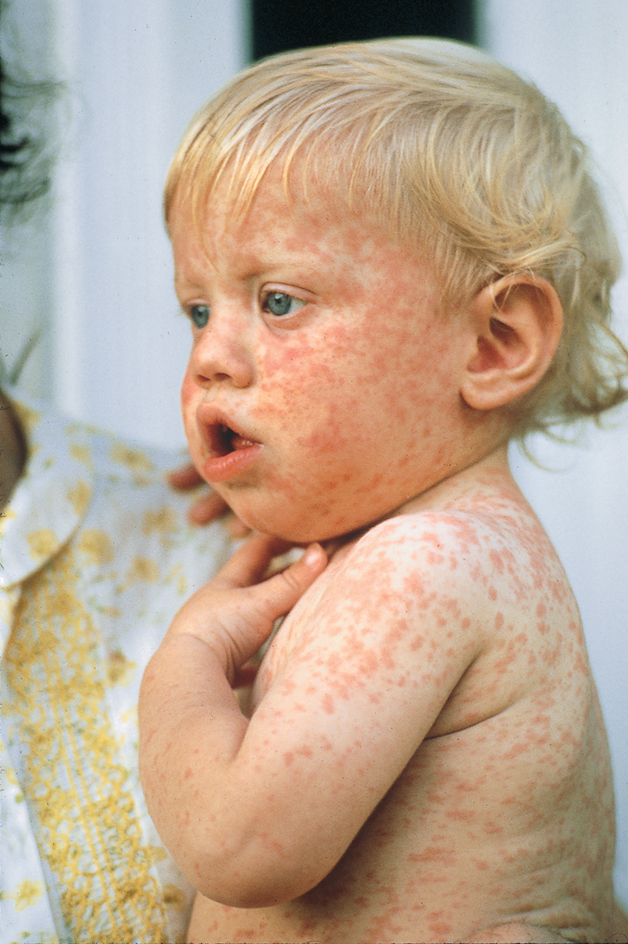Measles is a disease that causes a pink rash all over the body. It is extremely contagious. The disease occurs chiefly in children. But some young adults also catch it. Few people in the United States or Canada die of measles. But the disease kills many undernourished children in less developed countries. The medical name for measles is rubeola. German measles, known medically as rubella, is a different disease with similar symptoms.

Before the 1960’s, most children in the United States caught measles. In 1963, a team of virologists developed a measles vaccine. The American researcher John F. Enders headed the team. The vaccine was a major medical advance. By the early 1980’s, the use of this vaccine had practically eliminated measles from the United States. But some widespread outbreaks of measles occurred among children and young adults after that time. Measles remains common in some countries in Europe, Asia, the Pacific Ocean, and Africa. Travelers to areas with measles sometimes bring the disease back to the United States. Since 2000, measles outbreaks in the United States have occurred primarily in communities with significant unvaccinated populations or in areas frequented by international travelers.
Cause and effects.
A virus causes measles. People who have the disease spread the virus by coughing and sneezing. The first symptoms appear about 10 days after the virus enters a person’s body. A fever, cough, and runny nose develop. The eyes become red, watery, and sensitive to light. The fever may reach 105 °F (41 °C). Small pink spots with gray-white centers develop inside the mouth, especially on the insides of the cheeks. They are called Koplik’s spots. A person with symptoms of measles should call a physician.
Three to five days after the first symptoms appear, faint pink spots break out on the face near the hairline. The rash spreads all over the body within two or three days. About the time it reaches the feet, the patient’s fever drops. The runny nose and cough disappear. The patient’s rash begins to fade at the same time. Some people who are weakened by measles develop complications. The complications include infections of the lungs and the middle ear. The virus can harm the brain. But brain damage from measles is not common.
No drug exists to cure measles after it develops. Patients should be kept comfortable while the disease lasts. In most cases, a person has measles only once. The body produces antibodies (substances that fight infection) during the disease. These antibodies normally provide lifelong immunity (protection) from later attacks.
Prevention.
In 1954, Enders separated the measles virus from other substances. He then grew the virus in living cells in test tubes. He later developed a vaccine from the virus. Since 1963, millions of young children have received a single injection of the vaccine to prevent measles. It usually is given when the child is about 15 months old. Most American physicians recommend a second injection for older children or adolescents.
Measles vaccine contains live measles virus. The virus has been weakened by a long period of growth in animal cells in a test tube. When injected into a person’s body, this virus produces a mild form of the condition. In most people, no symptoms appear. But the body reacts to the weakened virus just as it would to an ordinary virus. That is, it produces antibodies that fight the virus. The antibodies provide immunity to measles. Scientists do not know how long the immunity lasts. In most people, it continues for many years—perhaps for life. In the United States, measles occasionally occurs in adolescents and young adults who have never received the measles vaccine. A few people get the disease who have received the vaccine only once.
The vaccine cannot stop measles from developing in someone who already has the virus. For a few children exposed to measles, doctors may try to prevent the disease by gamma globulin treatment. In this treatment, a doctor injects gamma globulin, a part of the blood. The gamma globulin comes from people who have had measles, and so it contains antibodies. Doctors give gamma globulin only to patients who are at risk of developing other, more severe disease.
